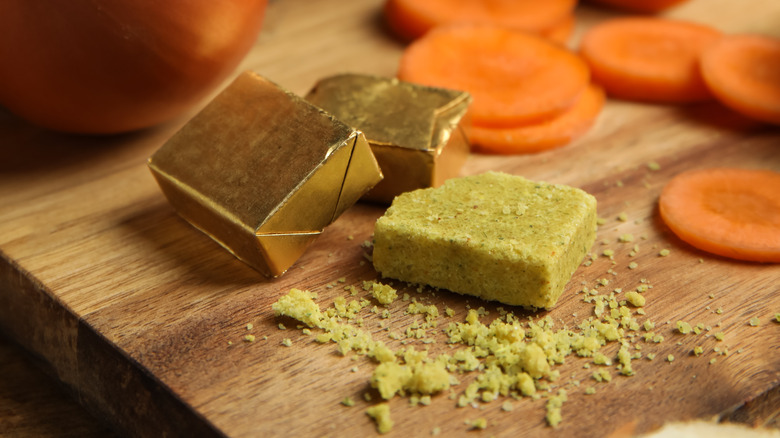How Humanity's Shared Love Of Broth Helped Birth The Bouillon Cube
It could be argued that humankind's ability to reason is what separates us from the rest of the animal kingdom. But, studies indicate that animals also have some capacity for reason (via the University of Houston). In any event, what really separates humans is a bit more specific. It starts with cooking. Whereas we can't think of any other animal that cooks their food before eating it, humans learned to boil their food early on. Nor can we think of any other creature that stirs water into foods to make something more abundant, and ideally, more nutritious. Serious Eats says this practice derives from humankind's inherent instinct to survive, and it likely gave rise to soups, broths, stocks, and stews.
It's probably safe to say that broth (or some version thereof) is a ubiquitous human dish. As the great French chef, Auguste Escoffier, once said, "without it, nothing can be done" (via Weston A. Price Foundation). Of course, it doesn't take a French chef to realize that. Without broth, there'd be no Mexican mole, no Spanish paella, no Moroccan harira, and no Canadian poutine. On the other side of the coin, without broth, there'd be no bouillon cube. In fact, it's humanity's dependence on broth that led to the birth of the bouillon cube. Of course, it also took a little innovation.
Love of broth and innovation birthed the bullion cube
The now-ubiquitous bouillon cube was first sold commercially sometime between 1908 and 1910 (per Serious Eats). Since then, it's been beloved as an inexpensive way to go from zero to broth in a matter of minutes (via Livestrong). Before that happened, however, humans first had to figure out how to extract the water out of the broth. The work began thousands of years ago, when humans realized they could boil the water out of some foods while leaving the flavor intact. By the early 1800s, Merriweather Lewis was carrying "portable soup" along on expeditions, per Lewis & Clark. This portable soup had a dried glue-like consistency that could be reconstituted with water.
Nevertheless, bouillon would not be dehydrated into tiny portable, mass-marketable cubes until 1910, per Serious Eats. But, the fun didn't end there. Indeed, many scientists kept working on water extraction techniques including the Japanese chemist, Kikunae Ikeda who figured out how to remove the water from kombu (a seaweed). And, in the process, he discovered the seasoning for monosodium glutamate (MSG): umami, which is now the word used to describe the "fifth flavor," – a portmanteau of the Japanese words for "delicious" and "taste" (per Umami Info).

